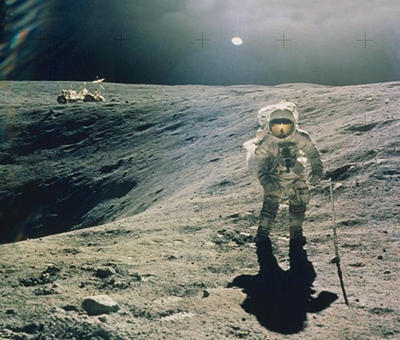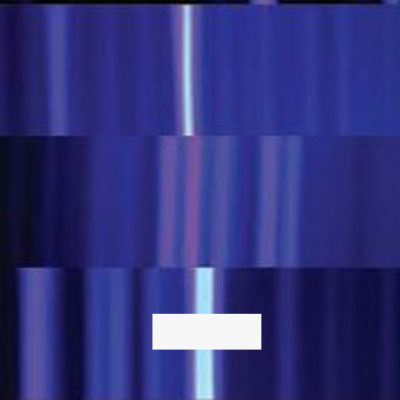Chapter 10. Human Exploration of the Moon
10.1 Introduction

Author: Jordan Raddick, Johns Hopkins University
Editor: Beth Hufnagel, Anne Arundel Community College

The goals of this module: At the end, you should be able to:
- Identify the missions that sent robotic probes and humans to the Moon.
- Discuss the video evidence that shows people visiting the Moon.
In this module you will explore:
- The history of human exploration of the Moon
- Videos of astronauts exploring the Moon
Why you are doing it: The Moon is the only celestial object that people have visited in person, and these visits are an important part of the story of how we understand the universe.
10.2 Background

In 1961, President John F. Kennedy gave a speech to Congress declaring that a goal of the United States was "landing a man on the Moon and returning him safely to the Earth." The decision to go to the Moon was made at least partly for political reasons - the U.S. was competing with the Soviet Union for the prestige that exploring space would bring. Throughout the 1960s, decisions made in both nations' space programs were undertaken with the goal of human exploration of the Moon. On July 20th, 1969, astronaut Neil Armstrong became the first person to walk on the Moon – a major accomplishment, made possible by the work of thousands of people on Earth.
Here, you will learn some of the history of missions to the Moon, and you will see the human exploration yourself, from video that was taken at the time on the Moon.
10.3 Stepping Stones to the Moon
The table below is a catalog of missions of robotic and human exploration of the Moon. Click on the names in the left column to view images of the spacecraft. Next to each mission name is the flag and name of the country that produced it, and the year it arrived at the Moon. There is also a brief description of what the mission accomplished. For missions that included human exploration, the people that went on the missions are listed. An asterisk (*) indicates people who walked on the Moon.
Click on the names in the left column to view the images. Study the table and answer the questions below.
| [Luna 1]{asset/luna1.png} |

|
USSR, 1959 First man-made object to leave Earth's gravity and fly by the moon |
| [Pioneer 4]{asset/pioneer4.png} |

|
US, 1959 First U.S. mission to fly by the moon |
| [Luna 2]{asset/luna2.png} |

|
USSR, 1959 First man-made object to crash-land on the Moon |
| [Luna 3]{asset/luna3.png} |

|
USSR, 1959 First photographs of the far side of the Moon |
| [Ranger 4]{asset/ranger4.png} |

|
US, 1962 First U.S. mission to the crash-land on the Moon |
| [Luna 9]{asset/luna9.png} |

|
USSR, 1966 First robotic Moon lander |
| [Surveyor 1]{asset/surveyor1.png} |

|
US, 1966 First U.S. robotic Moon lander |
| [Lunar Orbiter 1]{asset/lunarorbiter1.png} |

|
US, 1966 Orbiter to search for good sites for human landing |
| [Apollo 8]{asset/apollo8.png} |

|
US, 1968 First humans to orbit the Moon (Frank Borman, Jim Lovell, William Anders) |
| [Apollo 11]{asset/apollo11.png} |

|
US, 1969 First humans to land on the Moon (Neil Armstrong*, Edwin “Buzz” Aldrin*,Michael Collins) |
| [Apollo 15]{asset/apollo15.png} |

|
US, 1971 First use of a lunar rover (David Scott*, James Irwin*, Alfred Worden) |
| [Apollo 17]{asset/apollo17.png} |

|
US, 1972 Last humans to walk on the Moon (so far) (Eugene Cernan*, Harrison “Jack” Schmitt*, Ronald Evans) |
| [Hiten]{asset/hiten.png} |

|
Japan, 1990 First mission from a nation other than USA and USSR |
| [Clementine]{asset/clementine.png} |

|
US, 1994 Detailed mapping of the Moon |
| [Lunar Prospector]{asset/lunarprospector.png} |

|
US, 1998 Detailed mapping and scientific studies of the Moon |
| [Smart-1]{asset/smart1.png} |

|
European Space Agency, 2006 Europeans crash-land on the Moon, taking detailed pictures of the Lunar North Pole |
| [Kayuga]{asset/kayuga.png} |

|
Japan, 2007 The Japanese send a trio of orbiters to the Moon |
Question Sequence
Question 10.1
nS3FeI/ByIpISQqV6nzqR6KyjPaKKKiuRO0QZt2XBnR9J2Tc87jEbs+2YYvXkmHPlj2hyv1QQzZgTA69fqiBsqkw8GK91S0qaa6O+h65vemEvRX1cfAC5Xq6dcZlqPebxND4V3qUHJti9Ag7MJPxbKZpUWAYg+LwrKQA5kLTT46+ZeeoAQ3ZgXA66Vpcbrdap9WiNXupPhTVL8JsXEG76mOWOqe/MqJsm0oWtRMEbGOg8NI7OrXWzfjqbvwJ0ab/dsFMsSlWAkO+Z7+C8n7Ufe1Hr3TByUP8Thpu8MreVprvm1MGOrMc1Atd/mBF021sWkXKrjgy0fSR9zGTltF/ddDyUPln7R3d77gsFResYDBE4bhHrv+XYBDzG84pBQqDlrWjSt+M2Is6pKKsdgHWNTW1QYtaXPzGvjIPs6Rq0x9klRrUehHb9AJGGnChbHfTHqSwwyOuhhIAtNCixoXi9pHbYLSWlZ01s2JAzs3lEpVkdGt1VrkqZZzwIX1PIVH57wYMY1fHqVh8H7iVBXdP2a7HyldojrB0D4GGYAk+5vBdRdoHpKMdt4+/K5xMWu/HbjO6e6gbjF56l2uSJEEDCA89W8zHzveG92wk6EfaL4u2zfePWgb5u26l0G1Kw+OJIZF4OmDSh1lvYtZmur61OB+FLWpECGUbjEO2Em3Y3xGV/N7hNXHL8JVoPU2qU2AiWmqEICVGNkZYbUx4bGnpxmzDdJJS6kWaq1o3Dp8vOCTHp5im8sfIDw2U3Os1g5Fk1DjtAVrXrXY=Question 10.2
ef8wHExWOqH8R9aqJiI169WrOchLcJpdGQ1zBXzH0g3ZgNI90iUQxS8rM6YK923Zg5LDM2ZJTNoWjnG8VlwIhEpMh0GJI5Y7pTdrWeXJ/24NEecIv5QmINqn2lc3B3VCSWg2N2VxPoGizxtNdN/siFbJ3zxLB6I7IS53Lca11EZ7w4yFqR85Ad72MYZ5O3vcdkqlUT0S+J+3/uHbYrFEdYbcY7iP5RjCEWWKUGKoW9CEheuDDGDRkXYXWyv2F9YMCPrV5nsOJn8=Question 10.3
aYrDwI92/SWxwZrkeB5TmI8ts54X4Z/v7DDTaJ87RF3k2v6YLydiqKXQ6EiCCwU0LPqyL2TKYhyHYtDcPnuLdXTUjnzfkUazfLCg5vGwtKZoDiPlDa+HVdoa2qDFD5H4OqnnQEj/yPcAAoS87Lgv4CceMMEDdzOhrDTDm1vyP3sE2BANGinPq2tGT/upqAThjbR2hyyWbBQMCP9ap/TqF7v0R9sEMRGuqMilnfnUGGug2uYkxR35RwNsIjzb/4HdbylsXIExr6UIBK13kk7FFv0aj9uJRpzkksgTe5ozJc+CLV5VEZIe86muNCf9oaqh7t33YRjCYtVesqkSRHlU2UQMGp1xEMwkBKBTH+EhAw7Fg4Cj/XDQjoZ20nM8jNpcUlYDc/uYRlw1lYrYstdzpJHI68bMMDcwDyu02EkTGVc4P8p8CWB9oHKzIda9vlh5eF1Ogej3jqoqfeK4HI6S/cx4N40+C9eeO/MsiRGy4eiR7x11q/peQV8LEUMD2l8BKVs2cLbya2RCtJGzIvNGMwQXYIaDEvFqjJTN4Na81qoWMvBQ3yVuOxNl9nk7TEk9VNuefiW2jLdv4EgVzF0OUUNweuZVxCAHGDSo6lGJtBoOPXUqIrW308l/AHnfcClicUlQIjx77M1GZnbdXAYOeVsEWk9Sv4CIeXwEIXvlhkUd0Bo62m4pIKKJPUxUeUZWApzhK1fkWAXR0PgJ87mJTbcEpCKZc4KLzb+yBxQmJDDSWpBd1x1/bncGKDMxOeywIhw/NCIGUTWvMDgC48zwhSdqa+uEV42KClyVSvJpbBZOOPpsOtxVVk5fU8W+x1KW/X41IUkqWhfnHKI3BzbmLKGrsdGPCktWwKbGApsixkonjYYrUKq6gCRVyXTu39lufCpwdMfcxQcoqtFfazWweCQhiIHiT6Ac14SsDW/grZSnLOpo5MmAjtVmYfHbrfXrDoZbNC0g3fn3RwUB4cf30l53lkcsVqjWWJdlRc4DKw3Kx+MVeDzO5jv+IGMNcVnd91gDz1ANLYA9EXN6OCgOUJB1NBC//f2spe3PWfR7Cn1F5L52UE/AZg0ODPzW15fHUALS/WXfn10+TuNrFA4/jEMZGp1QGYFB7cPHrY8PKM8m7K7U8RoNAbdd3RFZtz6+C7c+f4Cp6e4J6aYakIUTyaLMqTKdmZWCuizy/69Vf6G6UgVV5o96MWk79p2wdw/dsZxlTSRmFYlvyAUAo2RYcIY1+F4Q8nQqamwf3NiWWRDcDDlZbknjvmoL4NUVAzeFbpDF0z3e68QkYgQWCHXQoSGJ8Lk1p/VollM7SdW4OqFMwUdkIFEVfuMpdYcA98cC1KTfgqYGLtvShEnQ4w8zYyk32udeJ2hKa0AgoZd55W67YT+JtnEOdgZZDEIIBcnVIh7RCnT67zfclXhCC6zB1jZPdkX9jLL0sbVnNK+Ok7rvMGK8NY/W9ntnEMhhvesEDySUrHUo/abNzYyZbQUE7/gDDQvTyRL7mFXmj4prc+7aeGL+wPz9HGxcgyxY5yLuQ17nUg3t/vhOUOaohffLhAkWtBGY6pyFuoCSMGuzheNhB34qgh+gCA0WPnIPJfhke2iLStaUBlqzp0n6bTzH+1UIMIKmqW1LO5ZAJp6BaWubm10S+/K67/NwC8umUUSUMxIhqt1u2w5B10sQGdHOR+4xOvqWga3+UMfcznLJe2VyEZedPF4UmZtFzU2nHAkmfN05KJJNph18ow3kn83MD4JZhBdRMSKYCUDxJxqSLoxhHaFkHBtChqrXAXwkn1uJjPX1ODtGV78zEFEtPxwRAHLlC1H2F64SF52PLy2CUwerkwPc9u0wsuuRYV3f2xwU0TdMLx4q4MukAXPDqbqeN1Dr8Ps=10.4 Landing On The Moon
Landing people on the Moon was an amazing accomplishment not just for American scientists, but for people around the world interested in the universe. Between 1969 and 1972, twelve astronauts walked on the Moon. They carried cameras and video equipment with them, and the pictures and videos were shown live around the world.
The two movies below, from NASA's archives, are original movies taken by astronauts on the Moon during the Apollo 16 mission. The one on the left has sound; the one on the right does not. Click Play to watch the videos, and answer the questions below.


Question Sequence
Question 10.4
zQDnVoC6owKpzYTXScL3wsOrA2o1QarLgiVyh6YRo5IY5Tn8gaXOwSIT8a61zPz71nkjsZFGUJHCHl3/i4/K+TnhAyHn+BWzisnZLkc90UUnlaZPfVdyYf6fo8XDCnHolqKM8FBUQv/LhojbbWlVOIivUoO1BoShQ5rRLyDMUWYRm7+AqGXsnUyeESbFCY2Gn/GRcLBx0KUB/q5NojRb/wI9ut0SPfaJNy928gCVnnEQ3mPzJxb6pT551Iuo0IlRmZT8qWbLk3yZnKWs/Yd3VoTcKzvD5jNNNRPgfCnFBJKPwSIbjz1hL2SXqUnCCfmAoRZYuXBrazjaukpocrS4EBX3lCq0NKB9VIZKc1ow9mUufKu8d7SKpsUt61ZYCSq0/7PuAUB1lnbbL/uRvQAchPix4IJtAypvsqVcGUPcR+lvLrBW+1MJUOrhGJcfS7gr3Yz8B/v74Vg10u9G5T5S4JThv9Dm/jFwZsZswHh3hKlvZdOIa2V33mnOetyy/k0jd74232iI4ZOJby9P8LmSIIgOZDeCtpvambVrCccgzUXsyg0Rf8jk2B2VfdoRG+JWitHlf7sjZd2eY+rlZHTbbKV03Qgcwglu53yLqs+g2b+ejMuyd/d66llE7KOdj2yi7pldVDsklo9r5OsSoXZM3WRTbkxnRdFzQuestion 10.5
bXzeuv/WuVQpgQZgO7PvJjNjRQqh8FxpsMURBoyfyyTy9fC/sPwzqiNPsVIiP7khKkpV3FpEBDToogJFNS4g0k7SmjrpIUyY326PxuLo6dO+cvAtc3F36sVlmznxjazoes5uyhBOLGHeNtF+AFDyUGMoszVcD3/JIEFD+p0FHWZLvesMCYSLnwcC1kumm2h0A8xCyD9P9kYrfHF3FjF5cuWzemvQzzYt2h6SqTlDXFbX3dil2Y1ogX+v2QomclJdgQNU+llZZ4o3WQiilRqyTcYmRkQMll3Ki/sXeME4BMz6jGr8tLS+/xISGInr55VzK+ZgdwkvC1WqXNG67HU3jKiwPicWheEPKlSmSKWO260RB903bzPI3hYJXlMqd4xVPdmnU0Yx2T4bt2nD+WSMN+dCGnfvdqqSTgRZqr/BBtzBf7m/JegoGgaYewEMS9grXKgRHtQ2benHS6XeKNycXb74KtNxo2rmU1Mmxvh0vInw9JX+9vf6MNeWA+yQkQXGXURwOb2qEmRoCIsQFZE8vxABiLnS5L0RylOpaPA+vh5f1UU0R16X0+sJmZXPB+XkxIlRXjXV3wPguNy2pDXm/tA+rTFjJ5sv3eg/6vXOA3dbe3G8xAeLjm+D2C6/JVDBUR1Pa+g/TZ2AZc/a8RzKRCj2MzfxTHa6c1vfPAoUH3KvJcGftfF26AaR9b8xjIMOGi7CR7Xi4v/ObkUuItxDy786uXhCkkHCthXZhhYO51YhCIKA/XLdJBLRl7yGn23fCNQo/mR/lOdD3SI8iYOFz8Jrrd/jp38ke/lEgwVaRrOrxby97gDhdemMfbpenqQeCAF3FJ8EEp/qd6hygN+bS//vQVx3bRvp9Bai9WCLh0DC8T+vt+VYIXh+YqfeNIH9hRFyaqO0SpLoTHxebKEPK+kM7xQRNUQrFVjLlddpMpPr6bm/PUSPqUUwh10AOuTH9chVsugtx+odSop+0jpwBnsCTgKQNVa8wM6w0JpY3fH2RamC3l2MZbeX73GgYi25+vu2X53YHTCy0JWJEM6Vl/TXbOe/VjBVoMH3AsTLLp6EgzvRaSMgLeS5tEo4TYxRoEXLuOE4CXoGgic0zDb0ufMNjYllIoENKQIkP8m9M7ChMnVWXX6qUChvaNLWQad6d1/aa0wRpWX65KXxjRPsT4yz+0eRtiOGGuBdalQt1S9KozqkV1F51v9MJh830JPCz71hf2QAugk7AS1ZcKDnlogEHurovUhebY7YwHGgDT7LEu0DQ7cGW1k0EdCKgmfSI7fRWOwiYyRyJsmnlDRqrUDQF2EjM5msd9QhKSoXDrYctYZ0VaQOcJETtHfVk62U1zqABEJqx7eAS+C6J4/lzBJgL7tIokywQlb59T6VCLWLAtvPvPY9jWtJYfLq3M6+UNk6YI0GJ5K7G7ASh39TM1ElV6NL75I4PP6paM3NFCJMm2LP4P5D0lJ8gjEHvL+0BUZa6gmGc5peZb/OTxNV5Ucl9m8e/uaLMPKzX6J3aG3r6CXMM+il7/VxznvMPIoy6q+yR3Hp7SpdJJIZtKtq4er/LQW+N2TSQo65LNZqr++jN3jIl5gdfXoiKml5Aw96zinB6+Apzya3OnEuZRZjZeKu8LlHvc/4QxYIX6LPEccUNJK2f0+boTX7qz0gMd4EkmF1aYdY/3Fth5HuQd11hUt4ehoRldEiqI3/nxflw2w7PqfigbGJ10FR0VT8twiXbJVJzDRG4yQPbokjKPIy2CMMrBijZklfQFIBW4Nmr35hgT9vFWoIExS3j7Pkduw2r26FiOWM1oYOLB//jIpljb0vPPH2RPJyvDxJ/hOrGL91DXATZvX5D6toLWMJJFpUW3++IetoFGr4qsRmVmWy4HNoH6X+gpfsxlWt7K2qRPWk4ybf3IZnwA9uwBMssgoFGcubU3tKV8b/AstTTkjC/CpOXrUeYmyr23cEeOd8Q3KKrMBKxN0vgBaFLSFMcGvvV4qN3pbodMIyGeAu/xVVfhX92+4D+H5Lpc6pMcfbBMVa5cC7yp9tdTaMYUmjGOgmuydAeoRf3TXLUbELXOfOxIgDx51vriglJEkRgw2f0nyj0bTNaNrzV1IDEg//oKCWgS/MxlOPlAksv9raMv6yuZ9bzCKo8bM+WZHH0Nx36As1WQZEBYbxZM3NPYyg7cs0QXF9vqf73jVqVdszlQFisYKgSbjZeeiFH0YsUw+MMOE/L26xYsoj47jf0YFXWkdO8TS4oMxAgz90UcI8L4PjtYOCUoDNzy1IYcMibjXzagFlbdgAB0+djjFmFlQwqpvulILfXltgidbN1tScF9+gu6b/MVTn6ZPevaKSWXL5jznmnBRo2anZ3pSndHh61ueoz89htfPiTZ16wQXeh96BKhxUfKO0dPxkfICoQ6GycOdfbGuS8JzEw1WfTgAebfNcW5CRbsWj6KI3V6Pzp36rwc2GBcQRubEwA1XF5FEzNXr17SEW3nX3vWffe6YJ75IgeUKDP/owjVU65Umy6S1EsuUUI+2X62Pv2qGDdQ4/DwHF/aSE+EPLjcTA3UA=Question 10.6
zHG7Z90lNrzIfZMg9gEVWk250e0IpHPJzFClDDLQX0vNq7AesAmVewRhRXT63j2brZhNH64WIk4w+KoPdpTcX+VNiU4c4v5zgkOSMB9ZulBmBBtCrXg+XLlgWjWuQseEYBorEut2GcjO4JoXotXSY4+EmawtQ1FQHXPjGjMxVbTtMPB8+8TMhAB53++phg4cmb7C7U0C3Pn/S8un05aLVo6HvTz29jM9Hi0rfbfu8BnXjkaZZ8Gmt1auflZ/aZT9DKpEPavkmbw=10.5 Will People Ever Walk on the Moon Again?
You may have noticed that the last person walked on the Moon in 1972, more than three decades ago. The Soviet Union never did land men on the Moon, since the race was over as soon as Neil Armstrong stepped onto the Moon. At this point, only two countries, the USA and China, are discussing sending people back to the Moon.

The USA's Moon program took a decade to accomplish, and close to $200 billion, or $20 billion a year. This is more than NASA's total budget for 2008! Is going back to the Moon worth intense effort for at least a decade and spending lots of money? What can be accomplished by humans that can not be done by robots?
Click on this link to get the sense, in five minutes, of how the first flight to the Moon mesmerized the entire world. Notice how the astronauts expressed their feeling of doing this for the entire world, not just the USA.
Stay tuned for future developments!
You're done with this activity. All that's left is the Quick Check.
10.6 Quick Check Quiz
Indepth Activity: Human Exploration of the Moon